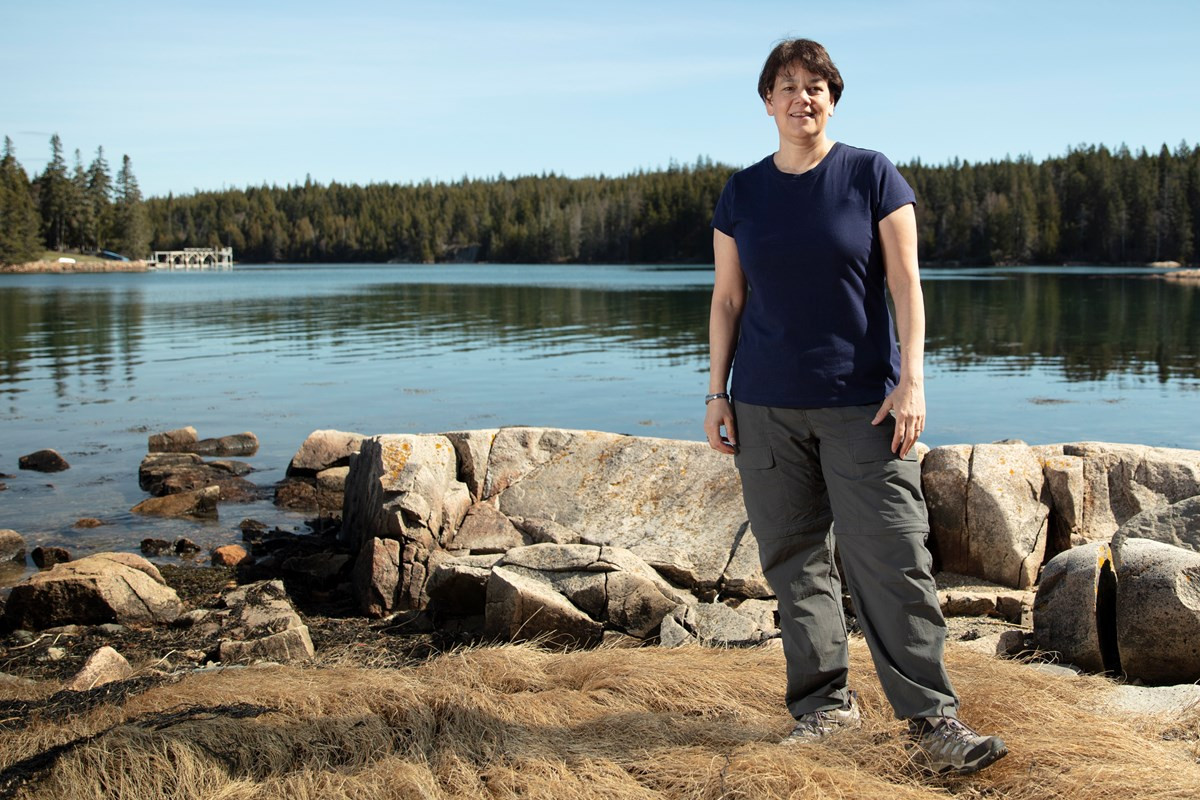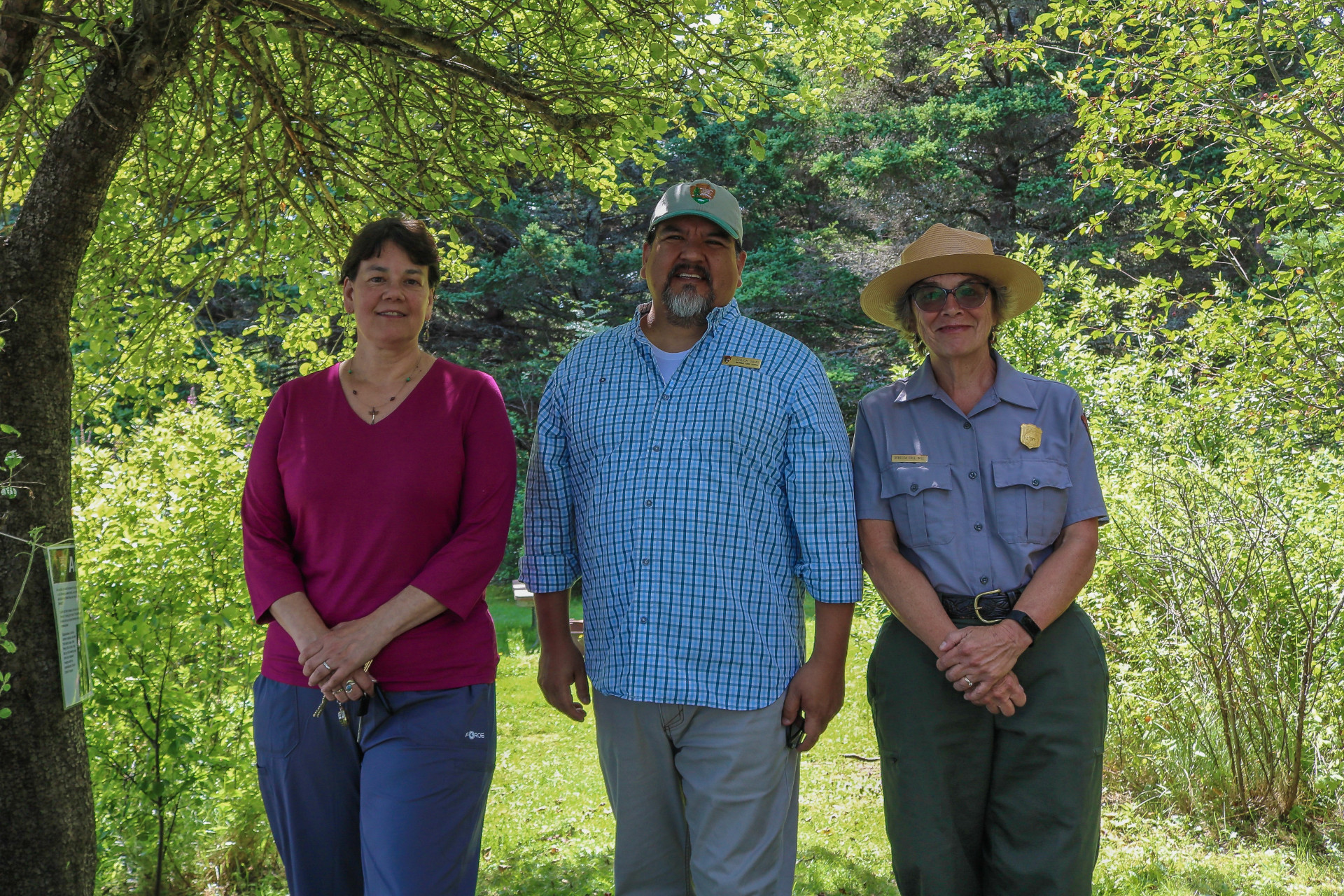An Interview with Dr. Bonnie Newsom
March 14th, 2023
March 14th, 2023
BY REBECCA COLE-WILL
Indigenous archeologist Dr. Bonnie Newsom is determined to reconnect Wabanaki communities with
their archeological heritage.
A citizen of the Penobscot Nation, Dr. Newsom is assistant professor of anthropology and faculty associate at the Climate Change Institute, University of Maine. She’s currently leading work in Acadia National Park to bring an Indigenous perspective to understanding archeological cultural heritage landscapes within the park.
Dr. Newsom serves on numerous national and state boards concerning cultural heritage preservation, and she is the mother of four and grandmother to three. Her work is important and groundbreaking. It is also underscored by a sense of urgency as rising seas and intensifying storms have already eroded away many
archeological sites in Acadia.
I’ve had the honor to know her for 25 years and to collaborate on her work for the last three. I recently interviewed Dr. Newsom about how climate change influences her work in Acadia and her eye toward bringing Indigenous knowledge and Western science together in archaeological research.

Dr. Newsom stands at an Indigenous archaeological site on the Schoodic Peninsula. (Photo courtesy Elliot Higger)
Rebecca: What was the “spark” that led you to the work you do now?
Dr. Newsom: As an undergraduate at UMaine, I was a little lost in terms of what I wanted to do with my career. I had dabbled with various career paths, but I hadn’t found something that fit well. That changed when I enrolled in an anthropology class with Dr. Cynthia Mahmood [former professor of Anthropology at the University of Maine]. Dr. Mahmood focused her research on the Sikhs. She was very inspirational because she worked to give a voice to the Sikhs in order to help the world understand their experiences and perspectives. It was a different kind of anthropology, and she really inspired me pursue an anthropology degree.
Kristin Sobolik, a former archaeology professor at UMaine, was influential as well. I asked her about archaeology and anthropology, and she said, “If you’re going into this career field and you want to be an archaeologist, you probably need field school [experience], to find out if you actually like it.”
I took her advice and applied for the Abbe Museum field school, was accepted, and spent a week excavating at an Indigenous archaeology site on the Maine coast. [Side note: this is where I met Dr. Newsom. I was archeologist at the Abbe and, with my husband, Rick, leading field schools at coastal shell mound sites.]
While I was there, a couple of things struck me. One was that there were no other Indigenous people participating, and that was one of the reasons why Dr. Mahmood encouraged me to move in this direction. At that time, there were very, very few Indigenous archaeologists nationwide.
The other thing that really inspired me was having the opportunity to connect with my heritage and ancestors through their material world. I encountered a lot of special items [artifacts] and exciting things during my first field school, but there was one drilled bear tooth that was particularly inspirational. I think it was in a hearth feature, and it was broken. But I was just so excited to find it because that one special item took the material culture out of the realm of function and made it personal. It was a piece of personal adornment that was different from the pottery sherds or stone tools in my excavation unit.
I began to think about who wore it and my connections to that person. And so it was at that moment that I realized that my ancestors have a special story to tell. I wanted to help tell that story. And I wanted to reconnect with my ancestors. I think archaeology can provide a pathway for other people in our community to reconnect, because there’s some distance there.
That’s my spark. I guess it’s having that opportunity to connect, and to connect others as well. We can honor those connections by maintaining some of those philosophies that guided our ancestors.
Rebecca: So, you were taking anthropology classes, but interested in archaeology? Or did you come to archeology because you wanted to do something that was important for your community?
Dr. Newsom: I was in anthropology, and I like cultural anthropology. I still do, but I felt there were more opportunities for me as an Indigenous archaeologist to fill a gap than with a cultural anthropology focus.
There are a lot of cultural anthropology aspects to my work. I consult ethnohistoric resources and engage with community to broaden my approach to archaeological interpretation. But I really think that [archeological resources] need our attention.
They’re very fragile. We’re going to lose them. These material remains are gifts, our ancestors’ gifts. I also find archaeology to be a tactile and physical experience that I really like. I enjoy the physical aspect of archaeology and to be the first Wabanaki person to hold an object that hasn’t been held by Wabanaki people in thousands of years—that’s very powerful.
Rebecca: Tell us about your approach to science, and incorporating and using two-eyed seeing in your work?
Dr. Newsom: Two-eyed seeing is a term coined by Albert Marshall, who was a Mi’kmaq elder, and it’s been in the literature since about 2012. It’s a process that brings Indigenous knowledge and Western science together for the benefit of all.
How that works for me is bringing the people together and putting Indigenous knowledge and Western science on an equal footing.
I think a lot of times what happens is Indigenous knowledge gets marginalized. It gets tacked on. And we’ve done ourselves a disservice in science by not making space for those other ways of knowing.
Language is really the key to understanding Indigenous science and scientific views of the world. I try to bring students, and fluent [Native] speakers, and cultural knowledge together to help scientists think differently…to help archeologists think differently, particularly about language and culture as a part of people’s lives in the past.
Archaeologists are already at a disservice because we’re not seeing the whole suite of material culture, anyway. And then [archeologists] neglect the Indigenous world view by applying a Western science perspective to the archaeological record.
So, I think bringing back that Indigenous world view through language gets us closer to how people may have viewed those materials. We have to remember that Native peoples had a different sort of relationship with material goods.
One of the things that I like to remind people of is that language is essential to archaeological interpretation. It brings in knowledge that’s rooted in how people engaged with their material culture and with each other.

Left to right: Dr. Newsom poses with National Park Service Director Chuck Sams, and Chief of Resource Management for Acadia National Park Rebecca Cole-Will during Sams’ visit to Acadia in 2022. Photo courtesy NPS
Rebecca: Climate change is a huge issue. How do you think about your work in relationship to what we are dealing with and what we understand about climate change?
Dr. Newsom: Well, you know, I’m coming at it through the lens of an archaeologist primarily. And so, of course, we know that climate change is destroying sites.
I’m a little frustrated by climate change in part because it’s not our doing. We [Indigenous peoples] didn’t cause this. There’s this movement to draw on ecological knowledge of Indigenous peoples or other kinds of knowledge to clean up this mess.
And that is frustrating as an Indigenous person, and thinking about where we are today, and where we might have been without colonization. And how it might have been different for us globally. I try and put that aside and work toward solutions.
We’re going to lose our heritage [coastal shell mound sites] and there may be nothing that we can do to prevent that in some situations.
Acting swiftly and keeping the momentum up for connecting people to their heritage spaces and the gifts that our ancestors left us is certainly a priority for me.
Our grandchildren, and then great grandchildren, will not have access to the same things that we have because of climate change. I see it as a responsibility to try and retain what we can in terms of heritage spaces and cultural materials before they’re gone.
That’s me as an archaeologist trying to think about what we can do about climate change. As a human and an Indigenous person, I believe strongly that we have got to change our philosophies. We have to look to the people who were able to do this successfully—to live sustainably.
Listen. Listen to the people. The Western view distinguishes humans from other living beings, like we’re disconnected.
If you think about us sharing the same energy or life force with all other living beings or non-human relatives, you might think differently about what and how much you consume. There’s a great quote by architect Carl Elefante, where he says, “The greenest building is the one that’s already built.”
I have this old house. It’s not the prettiest, but if you think about the trees that went into it as living beings, they’ve served us for 200 years as humans and we should be very appreciative of that.
That’s the kind of philosophy Wabanaki ancestors lived by and archaeology helps guide us in incorporating those philosophies into our contemporary lives.
Rebecca: I’m grateful for the work that you’re doing here, and the chance to be involved. This work is leading a revolution in the National Park Service. Thank you.
Dr. Newsom: I love my relationship with Acadia and the work that we’ve done together. I’m very proud of this work and I hope that we can continue to carry this forward, and whoever steps in after us.
Indigenizing Archaeology at Acadia National Park
Newsom, Bonnie, Natalie Dana Lolar, and Isaac St. John. 2021. In Conversation with the Ancestors: Indigenizing Archaeological Narratives at Acadia National Park, Maine. Genealogy 5: 96.
Schmitt, Catherine. 2022. Gathering Sweetgrass and Renewing the Past: How Science at Acadia Is Making
a Course Correction.
REBECCA COLE-WILL is the Chief of Resource Management for Acadia National Park.
Archaeologists bring Indigenous meaning and purpose to their science.
Read More